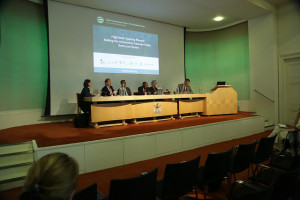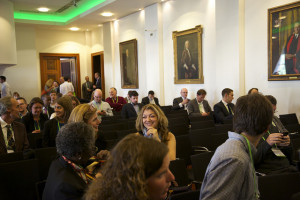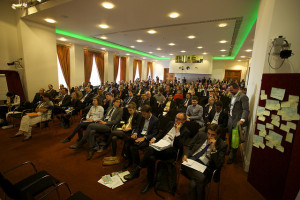By Leona Liu, originally posted at Forests News

In addition to addressing climate finance, one of the main topics discussed at the Global Landscapes Forum: The Investment Case was decoupling deforestation from supply chains.
“The Paris Agreement is significant because it brought forward the aspiration of staying below 2 degrees Celsius and put forests in the text,” said Marco Albani, Director of the Tropical Forest Alliance (TFA) 2020.
“But the Sustainable Development Goals (SDGs) are perhaps even more important. Among the various wedges in the current climate policy, the land use one probably has the biggest implications for all the other SDGs.”
The TFA 2020 was created in 2012 at Rio+20 after the Consumer Goods Forum (CGF) committed to zero net deforestation by 2020 for palm oil, soy, beef, and paper and pulp supply chains. The CGF partnered with the US government to create the public-private alliance with the mission of mobilizing all actors to collaborate in reducing commodity-driven tropical deforestation.

“There is a big role for the financial sector to play- particularly in terms of investment in the sustainable intensification of commodity production, which allows companies to meet their high demand for commodities, but without harming the forests,” he said.
As of today, financial institutions are not the biggest players in supply chains. Local finance institutions are generally the ones providing finance to smallholders.
“The big issue is that the majority of smallholders are independent like palm oil farmers in Indonesia, for example,” said Pablo Pacheco, Principal Scientist and Team Leader of Value Chains, Finance and Investments at CIFOR. “Smallholders have access to informal sources of finance, so companies often struggle to connect directly with them.”
“The private sector offers smallholders a secure market for their products, but they don’t necessarily pay for the costs to improve farming practices. For example, in the beef sector in Brazil, only big ranchers have enough capital to improve their farming practices. But medium scale and smallholders don’t have the capital to make these investments.”

Zwide Jere, Managing Director of the Malawi-based NGO Total Landcare, echoed Pacheco’s sentiment. “Today, there are very high interest rates for smallholders to access capital, especially in developing countries like my own. Interest rates are about 45 percent in Malawi. It’s sad that farmers need to accept these bad rates because they desperately need the access to finance.”
Still, progress on greening supply chains is encouraging.
“When I started working in this space, it was impossible even to know exactly how much deforestation there was, let alone where it was occurring,” said Albani. “Today, we have almost instantaneous information. We are able to trace back deforestation and allocate it to specific supply chains in a way that we’ve never been able to do before.”
Other key challenges tackled at the Forum included unclear tenure and government regulations, weak institutions, and the uncertain returns and unforeseen risks currently inhibiting investments at scale.
According to Holmgren, there are three key areas that require urgent attention. One is on the finance side- new tools are needed to help minimize the risks of investments and scale them up. Secondly, there is need on how financial services are done on the ground through local finance institutions. Thirdly, there is a need to better measure progress, both in terms of return on investments, but also in terms of sustainability outcomes.
Sessions at this year’s Forum ranged from diversifying financial instruments to realize REDD+, risk reduction measures for private sector investment in landscape restoration, the assessment of legal and policy frameworks for landscape investment in Africa, and how to link angel investors to land use startups.
Some of the liveliest discussions took place at a packed debate on the rise of financial system innovations like block-chains, mobile banking and the Internet of Things and how they can affect landscapes.
Digital innovations to enable and disrupt financial services, referred to as fintech, alongside mobile applications and GPS mapping software are helping to unlock the large-scale finance needed to address climate change and development challenges globally.
His solution? Software.
Software like GeoTraceability, recently acquired by PriceWaterhouse Coopers, offers specialized tracking and data collection technology like GPS mapping for natural resources including cocoa, coffee, and minerals globally.
It has facilitated the mapping and data collection of over 120,000 hectares of production in 11 countries, using GPS and GIS technologies. It has also collected data from 106,000 smallholders in developing countries, giving them information to help improve their production, farming practices, and supporting their access to international supply chains.
This technology helps mitigates the risk for investors who are wary of investing in smallholders, and encourages them to scale up their commitments.
“We can then attract off-takers to give us long-dated contracts and that’s how we can convert from liaising with diverse independent smallholders into a format that is bankable on a wholesale basis. That’s our objective.”
Prior to this, it was immensely complicated given the daunting task of aggregating millions of disparate smallholders. “There are four million smallholders in Indonesia alone involved in palm oil,” said Botsford. “A lot of them don’t have land titles. Two-thirds of them are in debt. So on the face of it, it’s just not bankable as a sector.”
“For the first time, you can address millions of smallholders at once. Before this software came along, you couldn’t do that. What it’s done, is make all these people eligible for finance and to bring them into the modern world, so it’s very exciting.”
Walking the talk
Beyond just stimulating conversation, the Forum’s key objective was for its participants to walk away with seeds of viable solutions for connecting capital to smallholders.
For the first time ever, a Dragon’s Den was held to allow presenters to pitch concrete investment opportunities to a panel of investors, finance experts and land use practitioners. All pitches introduced real projects at an advanced stage.
These funds demonstrated the volume of sound projects that exist out there today thirsty for private sector investment.
In his remarks at the Forum’s Closing Plenary, Burrows compared the private sector’s mounting interest in sustainable landscapes investment to a cresting wave with a long period of trough. Until recently, that wave was still in formation.
“Last year, when I spoke at the launch edition of this event, I said that the wave was about to break. Well, I think it broke in Paris during the COP. My hope is that when we meet again here next year, we would have seen an enormous change in terms of attitudes from the global financing institutions to financing sustainable development.”
Paola Agostini, Global Lead Resilient Landscapes for the World Bank, has already witnessed a change. “This Forum would have been impossible ten years ago. When I was in Liberia working on forests, we were trying to do partnerships- there was the public sector and the NGOs, but the private sector was largely absent. That’s no longer the case.”











